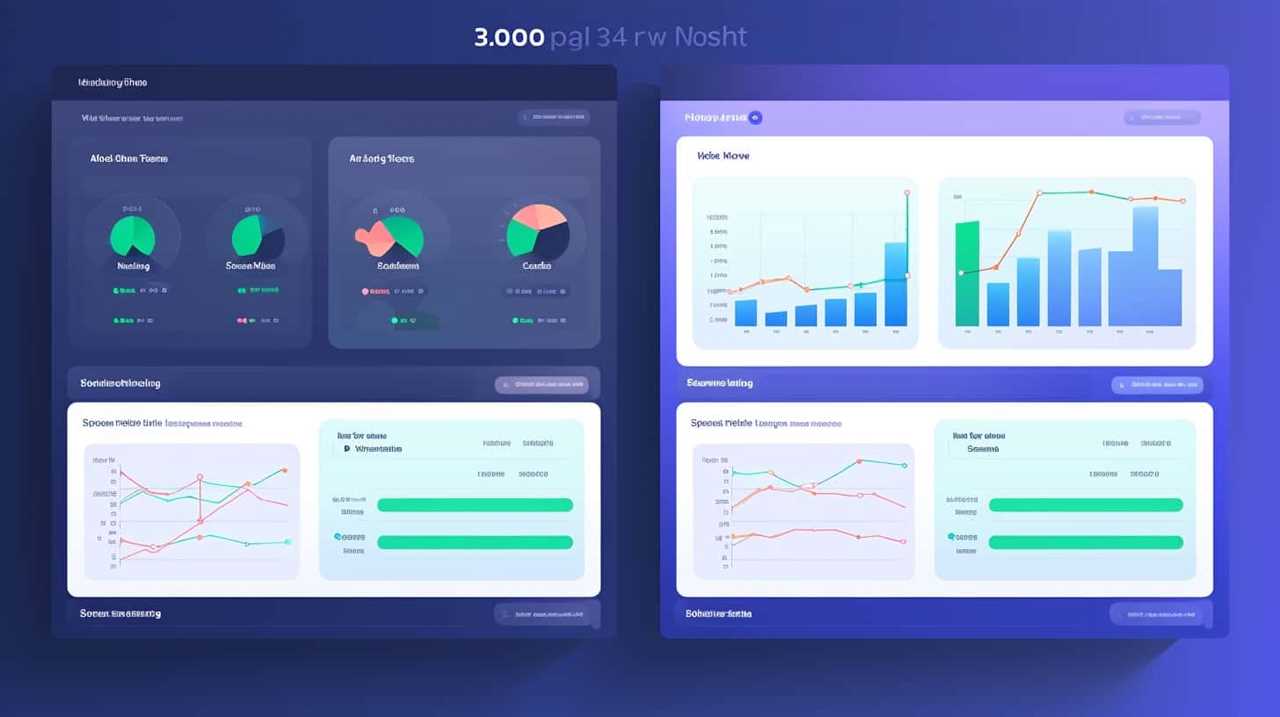Are you ready to take your small law firm to new heights? We’ve got just the right solution for you. This article will walk you through improving your website’s performance with SEO for the best possible outcomes.
From conducting keyword research to creating high-quality content, we’ll cover all the essentials.
Stay ahead of the competition by monitoring SEO metrics and staying updated with algorithm changes.
Let’s dive in and master the art of SEO for small law firms together.

Key Takeaways
- Effective SEO strategies are crucial for small law firms to enhance their online presence and attract potential clients.
- Thorough keyword research is essential for optimizing website content and driving organic traffic.
- Website optimization techniques such as improving loading speed, mobile responsiveness, and user experience are important for success in SEO.
- Monitoring and adapting SEO strategies, staying updated with industry news, and leveraging client reviews are vital for long-term success in SEO for small law firms.
Understanding SEO for Small Law Firms
In this article, we’ll discuss the importance of understanding SEO for small law firms. As legal professionals, it’s crucial to have a solid grasp of SEO strategies that can help your firm stand out in the digital landscape. With effective SEO techniques, you can attract more potential clients and drive organic traffic to your website.
When it comes to SEO strategies for small law firms, there are several key factors to consider. First and foremost, optimizing your website’s content is essential. This involves incorporating relevant keywords, creating informative and engaging blog posts, and ensuring that your website is user-friendly and easy to navigate.
Another crucial aspect of SEO is building high-quality backlinks. By obtaining links from reputable websites, search engines will view your site as authoritative and trustworthy, resulting in higher rankings. Additionally, optimizing your website’s loading speed and mobile responsiveness can greatly improve user experience, leading to higher search engine rankings.
Understanding SEO for small law firms is vital because it lays the foundation for successful online marketing. By implementing effective SEO techniques, you can increase your firm’s visibility, credibility, and ultimately, your client base.

Now that we’ve explored the importance of understanding SEO for small law firms, let’s delve into the next section: the significance of keyword research.
Importance of Keyword Research
When it comes to optimizing our small law firm’s website for success, understanding the importance of keyword research is crucial.
By targeting relevant keywords that potential clients are searching for, we can increase our search visibility and drive organic traffic to our website.
Keyword research allows us to identify the specific terms and phrases that are most relevant to our practice areas, helping us to rank higher in search engine results and ultimately attract more clients.

Targeting Relevant Keywords
Keyword research is an essential step in optimizing SEO for small law firms. By targeting relevant keywords, such as long tail keywords for niche legal services, you can increase your chances of ranking higher in search engine results and attracting more potential clients.
In today’s digital age, it’s also crucial to optimize for voice search in the legal industry. With the rise of virtual assistants like Siri and Alexa, people are increasingly using voice commands to search for information. By incorporating conversational phrases and natural language in your keyword strategy, you can ensure that your website is well-positioned to capture these voice search queries.
As we delve into the next section on increasing search visibility, we’ll explore additional strategies to help your small law firm stand out in the online landscape.
Increasing Search Visibility
To further enhance our online presence and attract more potential clients, we continue to focus on increasing search visibility through the importance of keyword research. By improving search rankings and optimizing website content, we can ensure that our law firm is easily discoverable by those in need of our services. Here are four key strategies we employ to increase search visibility:

- Thorough Keyword Research: We conduct extensive research to identify the most relevant and high-performing keywords in our industry. This helps us understand the language our potential clients are using to search for legal services.
- Content Optimization: We strategically incorporate these researched keywords into our website content, including page titles, headings, and meta descriptions. This ensures that search engines understand the relevance of our web pages.
- Regular Content Updates: We regularly update our website with fresh, informative, and engaging content. This not only keeps our audience engaged but also signals to search engines that our website is active and relevant.
- Link Building: We actively seek opportunities to build high-quality backlinks to our website. These links from reputable sources help to establish our website’s authority and credibility in the eyes of search engines.
Driving Organic Website Traffic
In order to drive organic website traffic and increase our online visibility, we focus on the importance of conducting thorough keyword research. By identifying the keywords and phrases that potential clients are using to search for legal services, we can optimize our website for those specific terms. This not only improves our website’s visibility in search engine results but also increases the chances of attracting qualified leads.
Keyword research plays a crucial role in improving website conversion rates. By targeting the right keywords, we can optimize our content and tailor it to the needs and expectations of our target audience. This leads to higher engagement and a greater likelihood of visitors taking the desired action, whether it’s filling out a contact form or scheduling a consultation.
Additionally, optimizing for local search is essential for small law firms. By incorporating location-specific keywords and creating content that’s relevant to our local community, we can attract potential clients who are actively seeking legal services in our area.
Now that we understand the importance of driving organic website traffic through keyword research, let’s explore the next aspect of optimizing our online presence: optimizing website structure and navigation.

Optimizing Website Structure and Navigation
We recommend using a clear and intuitive website structure and navigation system to enhance user experience and improve SEO rankings. A well-organized website structure is essential for search engine optimization and can greatly impact your online visibility.
Here are four key ways to optimize your website structure and navigation:
- Simplify your website hierarchy: Create a logical and hierarchical structure for your website by organizing your content into categories and subcategories. This will help search engines understand the relationship between different pages and improve the overall user experience.
- Use descriptive and keyword-rich URLs: Optimize your URLs by using descriptive keywords that accurately reflect the content of each page. This not only helps search engines understand the relevance of your pages but also improves the user experience by providing clear and informative URLs.
- Implement breadcrumb navigation: Breadcrumb navigation not only helps users navigate your website but also provides additional context to search engines. It allows users to easily track their path on your website and helps search engines understand the hierarchy and structure of your website.
- Optimize your internal linking structure: Internal links are important for both user experience and SEO. By strategically linking relevant pages within your website, you can guide users to valuable content and help search engines discover and index your pages more effectively.
Crafting Compelling Meta Tags and Descriptions
Crafting Compelling Meta Tags and Descriptions is a crucial step in optimizing SEO for small law firms.
When it comes to improving your website’s visibility and attracting potential clients, crafting effective titles and optimizing meta tags and descriptions can make all the difference. These elements not only help search engines understand the content of your web pages but also entice users to click on your website in the search results.

Crafting effective titles is essential for grabbing the attention of both search engines and users. Your title should accurately represent the content of your page while incorporating relevant keywords. Keep it concise, engaging, and informative to make a strong first impression.
Optimizing meta tags and descriptions involves providing a concise summary of your page’s content. These snippets appear in the search results, giving users a glimpse of what they can expect if they click on your website. Use relevant keywords and compelling language to entice users to click through to your site.
Creating High-Quality, Informative Content
When it comes to creating high-quality, informative content for our small law firm, there are three key points we need to keep in mind.
First, conducting relevant keyword research will help us understand what our target audience is searching for and allow us to optimize our content accordingly.

Second, crafting compelling blog post titles will capture the attention of potential clients and make them more likely to click and engage with our content.
Lastly, we must ensure that our content is user-friendly in terms of formatting, making it easy for readers to navigate and find the information they need.
Relevant Keyword Research
To optimize our content for success, we conduct relevant keyword research to create high-quality, informative content. Keyword research is crucial in identifying the right keywords to target and understanding keyword competition in our industry. Here are four key points to consider when conducting keyword research:
- Identify long tail keywords: Long tail keywords are specific phrases that are less competitive but highly targeted. By incorporating long tail keywords into our content, we can attract a more focused audience and increase our chances of ranking higher in search engine results.
- Analyze keyword competition: It’s essential to assess the competition level for each keyword we want to target. By understanding the competition, we can determine if it’s feasible to rank for certain keywords or if we need to focus on less competitive alternatives.
- Use keyword research tools: Utilizing keyword research tools like Google Keyword Planner or SEMrush can provide valuable insights into search volumes, competition levels, and related keywords. These tools help us make informed decisions about the keywords to target.
- Create informative, high-quality content: Once we’ve identified our target keywords, it’s crucial to create content that provides value to our audience. Informative, well-written content not only helps with SEO but also establishes our expertise and credibility.
By conducting relevant keyword research and creating high-quality, informative content, we can optimize our website for search engines and attract more organic traffic.

Now, let’s move on to the next section about compelling blog post titles.
Compelling Blog Post Titles
For small law firms, creating high-quality, informative content starts with crafting compelling blog post titles. These titles are crucial because they serve as the first impression for potential readers. A captivating title not only grabs attention but also entices visitors to click and read the entire blog post.
When creating engaging blog post content, it’s important to consider the keywords that will appeal to your target audience. By incorporating relevant keywords into your titles, you increase the chances of your blog posts being discovered through search engines.
Additionally, promoting your blog posts through various channels, such as social media and email newsletters, can help drive traffic and increase visibility. Remember, the key to success lies in delivering valuable content that addresses the needs and interests of your audience.

User-Friendly Formatting
As we continue our discussion on optimizing for success in SEO for small law firms, let’s now delve into the importance of user-friendly formatting in creating high-quality, informative content.
When it comes to improving readability and enhancing visual appeal, small law firms need to pay attention to the way their content is presented. Here are four key strategies to achieve this:
- Use headings and subheadings: Break your content into logical sections to make it easier for readers to scan and find the information they need.
- Incorporate bullet points and numbered lists: These formatting elements help to organize information and make it more digestible for readers.
- Utilize white space: Don’t overwhelm your readers with dense paragraphs. Leave enough white space to give the content room to breathe and make it visually appealing.
- Include multimedia elements: Enhance the user experience by incorporating images, videos, and infographics that complement the text and engage the audience.
Leveraging Local SEO for Targeted Visibility
We implement local SEO strategies to enhance targeted visibility for small law firms. One key aspect of local SEO is local citation building.
Local citations are online mentions of your law firm’s name, address, and phone number (NAP) on other websites. These citations help search engines like Google understand the legitimacy and relevance of your firm in a local context.

By ensuring consistent and accurate NAP information across various online directories, such as Yelp, Yellow Pages, and local business listings, you can improve your local search rankings.
In addition to local citation building, targeting local keywords is another crucial aspect of our local SEO strategy.
By optimizing your website content with keywords that are specific to your local area, such as ‘personal injury lawyer in [city]’ or ‘divorce attorney near me,’ you can attract more relevant traffic to your website.
This strategy helps you connect with potential clients who are actively searching for legal services in your area, increasing the chances of converting them into clients.

By leveraging local SEO strategies like local citation building and targeting local keywords, small law firms can significantly improve their visibility in local search results.
In the next section, we’ll explore another important aspect of SEO for small law firms: building a strong backlink profile.
Building a Strong Backlink Profile
To continue our discussion on enhancing targeted visibility through local SEO, let’s now delve into the importance of building a strong backlink profile for small law firms. Building a strong backlink profile is crucial for small law firms to establish authority and improve their search engine rankings. Here are four key strategies to consider:
- Guest posting: Writing high-quality articles for reputable legal websites and including a backlink to your law firm’s website can greatly enhance your backlink profile. This strategy not only establishes your expertise but also drives traffic to your site.
- Partnering with other law firms: Collaborating with other law firms to create informative content or participate in joint marketing efforts can help you acquire backlinks from trusted sources. It’s a win-win situation that builds authority for both parties involved.
- Utilizing legal directories: Listing your law firm in reputable legal directories not only helps potential clients find you but also provides valuable backlinks. Make sure to choose directories that are relevant to your practice area and have a strong online presence.
- Creating compelling content: Producing high-quality, informative content that’s relevant to your target audience will naturally attract backlinks. Focus on creating valuable resources such as blog posts, case studies, and legal guides that other websites would want to link to.
Utilizing Social Media for SEO Benefits
Continuing our exploration of enhancing targeted visibility through local SEO, let’s now delve into how social media can be utilized to maximize SEO benefits for small law firms.

Social media engagement has become an integral part of any successful online marketing strategy. By creating a well-defined social media strategy, small law firms can effectively boost their search engine rankings and increase their online visibility.
One of the main advantages of utilizing social media for SEO is the ability to generate high-quality backlinks. By sharing valuable content and engaging with your audience on platforms such as Facebook, Twitter, and LinkedIn, you can attract natural links from reputable websites. These backlinks signal to search engines that your website is trustworthy and authoritative, leading to higher rankings in search results.
In addition to building backlinks, social media engagement also helps to improve your website’s overall visibility. When you share content on social media, it increases the chances of your website being discovered by potential clients. Moreover, active participation in social media communities can lead to increased brand awareness and exposure.
To maximize the SEO benefits of social media, it’s important to develop a comprehensive social media strategy. This involves creating engaging content, regularly interacting with your audience, and monitoring the performance of your social media campaigns. By aligning your social media efforts with your overall SEO strategy, you can effectively enhance your online presence and attract more targeted traffic to your website.

Optimizing Website Speed and Performance
When it comes to optimizing website speed and performance, there are two key points to consider:
- The importance of mobile-friendly design and minimizing page load time. With more and more people accessing websites through their smartphones and tablets, ensuring that your site is mobile-friendly is crucial for both user experience and SEO.
- Minimizing page load time is essential in today’s fast-paced digital world, as users expect instant access to information.
Mobile-Friendly Design Importance
By optimizing website speed and performance through mobile-friendly design, we can enhance the user experience and improve search engine rankings. Mobile devices are becoming the primary means of accessing the internet, and having a responsive design is crucial for small law firms to stay competitive in the digital space.
Here are four reasons why mobile-friendly design is important for your website:
- Improved User Experience: A mobile-friendly design ensures that your website adapts seamlessly to different screen sizes, making it easier for users to navigate and find the information they need.
- Faster Page Load Times: Mobile users expect websites to load quickly, and a mobile-friendly design helps optimize your website’s loading speed, reducing bounce rates and keeping visitors engaged.
- Higher Search Engine Rankings: Google prioritizes mobile-friendly websites in its search results, so having a mobile-friendly design can significantly improve your organic search visibility and drive more traffic to your website.
- Competitive Advantage: Investing in a mobile-friendly design sets your small law firm apart from competitors who may not have optimized their websites for mobile devices. It shows that you value your users’ experience and are committed to staying up-to-date with the latest technology trends.
Minimizing Page Load Time
To further enhance the user experience and improve search engine rankings, we focus on minimizing page load time and optimizing website speed and performance. One crucial aspect of reducing page load time is improving server response. By ensuring that our servers are efficient and responsive, we can deliver web pages quickly to our users. Another important factor is optimizing image sizes. Large images can significantly slow down a website, so we employ techniques such as compression and resizing to optimize the size of images without compromising their quality. By implementing these strategies, we can create a website that loads quickly and provides a seamless browsing experience for our visitors.

| Strategies for Minimizing Page Load Time |
|---|
| Improving server response |
| Optimizing image sizes |
Implementing Mobile-Friendly Design
Implementing mobile-friendly design is essential for optimizing the website of small law firms and improving their overall online visibility. With the increasing number of people accessing the internet through their mobile devices, it’s crucial for law firms to ensure that their websites are responsive and user-friendly on all screen sizes.
Here are four key reasons why small law firms should prioritize mobile-friendly design:
- Improved User Experience: Responsive design allows your website to adapt to different devices and screen sizes, providing a seamless and enjoyable browsing experience for your potential clients. By optimizing your website’s user interface for mobile, you can enhance navigation, readability, and overall usability.
- Higher Search Engine Rankings: Mobile-friendliness is a crucial factor that search engines consider when ranking websites. By having a mobile-friendly website, you’re more likely to rank higher in search engine results pages (SERPs), which can lead to increased organic traffic and potential clients.
- Increased Mobile Traffic: As more people rely on their smartphones and tablets to search for legal services, having a mobile-friendly website can attract a larger audience and drive more traffic to your site. By optimizing for mobile, you can tap into the growing mobile market and expand your reach.
- Better Conversion Rates: A mobile-friendly website not only improves user experience but also increases the likelihood of visitors converting into leads or clients. By providing a seamless mobile experience, you can encourage visitors to take action, such as contacting your law firm or filling out a consultation form.
Maximizing User Experience and Engagement
Our goal is to create an engaging and user-friendly website that maximizes the overall experience for potential clients. To achieve this, it’s crucial to focus on increasing user retention and improving website accessibility.
Increasing user retention is all about keeping visitors on your website for longer periods of time. One way to achieve this is by providing valuable and relevant content that keeps users engaged and encourages them to explore further. By creating informative blog posts, articles, and videos, you can establish yourself as an authority in your field and keep potential clients coming back for more.

Improving website accessibility is essential for ensuring that all users, including those with disabilities, can easily navigate and interact with your website. This can be achieved by implementing features such as alt text for images, transcripts for videos, and clear navigation menus. Additionally, optimizing your website for mobile devices and ensuring fast loading speeds can also improve user experience.
Monitoring and Analyzing SEO Metrics and Data
We track and analyze SEO metrics and data to optimize our website’s performance. By monitoring and analyzing these metrics, we gain valuable insights into our website’s visibility and rankings on search engine results pages.
Here are four key ways in which we leverage SEO metrics and data to enhance our online presence:
- Analyzing Competitor Strategies: We closely examine the SEO strategies employed by our competitors to identify their strengths and weaknesses. By understanding their tactics, we can adapt and improve our own strategies to stay ahead in the game.
- Tracking SEO Trends: SEO is an ever-evolving field, and staying up-to-date with the latest trends is crucial. We monitor industry trends and algorithm updates to ensure that our website remains optimized for search engines and maintains its competitive edge.
- Identifying Keyword Performance: Analyzing SEO metrics helps us determine the performance of the keywords we’re targeting. By identifying high-performing keywords, we can optimize our content and improve our search engine rankings.
- Measuring Website Traffic and Engagement: SEO metrics provide valuable insights into the amount of traffic our website receives and how users engage with our content. By tracking metrics such as bounce rate, time on page, and click-through rates, we can identify areas for improvement and enhance the overall user experience.
Staying Updated With Algorithm Changes
Staying updated with algorithm changes is crucial for small law firms to effectively optimize their SEO strategies. Adapting to algorithm changes is an ongoing process that requires constant vigilance and a proactive approach. By staying ahead of algorithm updates, small law firms can ensure that their websites remain visible and competitive in search engine rankings.

To help you navigate the ever-changing SEO landscape, here are some strategies for staying ahead of algorithm updates:
| Strategy | Description |
|---|---|
| Continuous Monitoring | Regularly monitor industry news and updates from search engine providers to stay informed about algorithm changes. |
| Analyze Data and Metrics | Use analytics tools to track website performance and identify any fluctuations or patterns that may be related to algorithm updates. |
| Stay Flexible and Adaptive | Be willing to adjust your SEO strategies and make necessary changes to align with new algorithm requirements. |
By incorporating these strategies into your SEO efforts, you can be better prepared to adapt to algorithm changes and maintain a strong online presence for your small law firm.
Now, let’s transition into the next section where we will explore the importance of incorporating voice search optimization into your SEO strategy.
Incorporating Voice Search Optimization
To effectively incorporate voice search optimization into our SEO strategy, small law firms must understand the growing importance of voice search in online user behavior. Voice search is becoming increasingly popular, with more and more people using voice assistants like Siri, Alexa, and Google Assistant to search for information.

Here are four key considerations for small law firms looking to optimize for voice search:
- Conversational Keywords: Voice search queries are often longer and more conversational in nature. Incorporating natural, long-tail keywords into your website content can help improve your visibility in voice search results.
- Featured Snippets: Voice assistants often pull information from featured snippets to provide quick answers to user queries. By optimizing your content to appear in featured snippets, you increase your chances of being the source of information delivered by voice search.
- Mobile Optimization: Voice search is closely tied to mobile usage. Ensuring that your website is mobile-friendly and loads quickly on mobile devices is crucial for voice search optimization.
- Local SEO: Many voice searches are location-specific. Optimizing your website for local search, including listing your firm on local directories and using location-specific keywords, can help you appear in voice search results for users in your area.
Enhancing Online Reputation Through Reviews and Testimonials
Enhancing online reputation through client reviews and testimonials is crucial for small law firms seeking to optimize their SEO strategy. Leveraging online testimonials and managing online reviews can significantly impact a law firm’s online visibility and credibility.
Positive client reviews and testimonials serve as social proof, demonstrating to potential clients that your firm is trustworthy and capable. They can help build a positive online reputation, differentiate your firm from competitors, and attract new clients. When optimizing your SEO strategy, it’s important to encourage satisfied clients to leave reviews on platforms like Google My Business, Yelp, and Avvo.
To effectively manage online reviews, promptly respond to both positive and negative feedback. Show appreciation for positive reviews and address any concerns raised in negative reviews. This demonstrates your commitment to client satisfaction and can help mitigate the impact of negative feedback.

When leveraging online testimonials, consider displaying them prominently on your website, including relevant keywords in the testimonial text. This can enhance your website’s visibility in search engine results and improve your SEO rankings.
Conclusion
In our journey to optimize SEO for small law firms, we’ve discovered the keys to success.
Like a compass guiding us through the digital landscape, keyword research helps us navigate towards higher rankings.
Crafting compelling meta tags and descriptions is like unlocking a door to capture attention.

And just as a sturdy foundation supports a building, optimizing website structure and navigation lays the groundwork for success.
By staying updated with algorithm changes and incorporating voice search optimization, we can enhance our online reputation and ensure our law firms thrive in the ever-evolving world of SEO.









